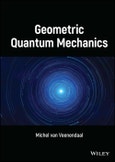Unique senior undergraduate/graduate level textbook on quantum mechanics that employs an intuitive, geometry-driven approach to the subject
Geometric Quantum Mechanics is a textbook for quantum mechanics at the senior undergraduate and graduate level and follows a unique approach to the material. The first chapter starts with the discussion of the properties of space leading to an understanding of operator techniques, Pauli matrices, spinors, quantum angular momentum, etc. Techniques from geometric algebra is frequently employed leading to more intuitive insights into the concepts.
The second chapter extends the results to spacetime. The study of the motion in and the production of electromagnetic fields leads to the Lorentz and Maxwell equations, respectively. The nonrelativistic limit leads to the Schrödinger/Heisenberg equations. This provides an overview how different fields are linked to each other.
The following chapters discuss applications of quantum mechanics. This covers a very broad area of physics showing how the ideas from quantum mechanics affect different fields. These are subdivided into chapters on single-particle problems, many-particle systems, and collective and emergent phenomena. The coverage includes the fundamental forces, atoms, molecules and solids, nuclear and particle physics, mass generation and the Higgs field, superconductivity, superfluidity, etc. The book restricts itself to the essence of these topics allowing the reader to understand how quantum mechanics impacts modern-day physics and chemistry. It appeals to instructors and students due to its different approach with its extensive use of geometric algebra and the broad range of modern applications.
Table of Contents
1 Space
1.1 The exponential function
1.2 The two-dimensional plane
1.3 Calculus and operators
1.4 Function space for rotation in a plane
1.5 Three-dimensional space
1.6 Spinors
1.7 Pauli matrices
1.8 Rotation matrices
1.9 Projections
1.10 Function space in three dimensions
1.11 Fourier transform and translation
1.12 Dual bases
1.13 Dual basis obtained via matrix inversion
1.14 The unit sphere
1.15 Function space for rotation in three dimensions
1.16 Higher-order operators
1.17 Operator techniques for angular momentum
1.18 Chapter summary
2 Spacetime
2.1 Introduction
2.2 The four-vector
2.3 Four-momentum for particles
2.4 Function space for spacetime
2.5 Spacetime spinors
2.6 γ matrices
2.7 Motion in an electromagnetic field
2.8 Creation of electromagnetic fields: Maxwell’s equations
2.9 Nonrelativistic limit of Dirac equation
2.10 Interactions between particles and electromagnetic field
2.11 Spin-orbit coupling
2.12 Spin-orbit coupling
2.13 Schrödinger/Heisenberg equations and propagators
2.14 Electroweak interaction
3 Single-particle problems
3.1 Introduction
3.2 Quantum harmonic oscillator
3.3 Perturbed harmonic oscillator
3.4 Two-dimensional harmonic oscillator via differential equation
3.5 Two-dimensional harmonic oscillator via unit vectors
3.6 Radial equation for hydrogen atom
3.7 Transitions on atoms
3.8 Molecules and solids
3.9 Periodic potential in a solid
3.10 Scattering from local potential
3.11 Single state and a band
4 Many-particle systems
4.1 Introduction
4.2 Wavefunctions for many-body systems
4.3 Quantum statistics
4.4 The Fermi sea in solids
4.5 Tensors
4.6 Electon interactions on an atom
4.7 Strong interaction: mesons
4.8 Strong interaction: baryon
4.9 Nuclear structure
5 Collective and emergent phenomena
5.1 Magnetism
5.2 Superconductivity
5.3 Mass generation
5.4 Symmetry breaking
5.5 Screening in solids
5.6 Plasmons in solids
5.7 Superfluidity







